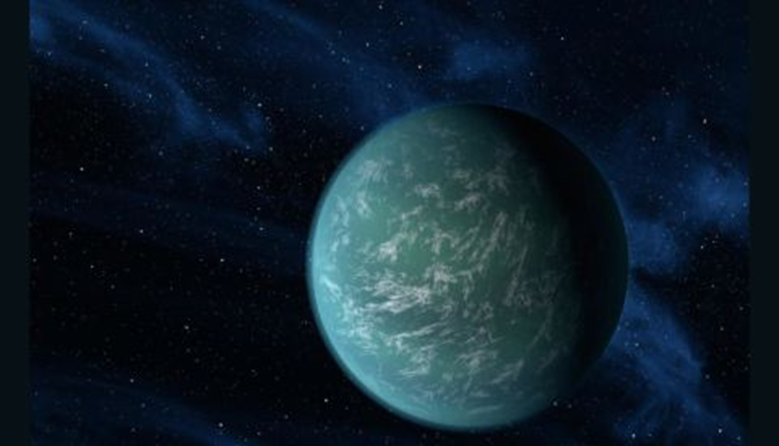“Super Earth” .. Observation of an exoplanet that may be a water planet without land

Scientists have discovered what they call a "super-Earth", which looks like an ocean world completely covered in water. It seems that a planet outside the solar system located 100 light-years from Earth, may be the best candidate, which scientists think is a planet completely covered with water. This exoplanet was named TOI-1452b.
Measurements taken for the planet's size and mass are consistent with the specifications of a liquid-soaked planet. Scientists believe that such worlds exist, but there is no conclusive evidence to prove this.
Although the initial results of observations of this exoplanet seem very exciting, it is necessary to persevere in conducting more observations using the James Webb Telescope, and studying the atmosphere to verify its nature.
A team of researchers led by Charles Cadio from the University of Montreal in Canada wrote: “The results of the research reveal the location of the exoplanet TOI-1452b, and its temperate climate. Modeling results of the internal structure of the planet also show that it is exposed to moderate amounts of radiation, which makes it a suitable candidate to be a water planet.”
It's easy to understand how this planet has so far remained out of telescope observation, even though it is relatively close to the Solar System.
This exoplanet was found orbiting a pair of nearby dark red dwarf stars. The distance between TOI-1452b and the binary of dwarf stars is set at 97 AU, making the two dwarf stars appear to be one star.
The sensitivity of the telescope (TESS) that observes exoplanets allows it to capture objects as they transit, as the telescope can detect the dimming of a star's illumination, which means that an exoplanet crosses between us and its host star.

The researchers refined the study results by taking advantage of the Mont Megantic Observatory in Canada, a highly sensitive observatory designed to detect transits of exoplanets.
After studying the observations using the aforementioned telescopes, the researchers confirmed the presence of an exoplanet orbiting one of the stars of the TOI-1452 binary system.
Also, researchers have verified that this exoplanet is relatively small, at 1.672 times the size of Earth. That's why they called it the "super-Earth".
This discovery came after studying the amount of light radiated by the surrounding star, and the dimming that occurs when the exoplanet passes in front of it.
This exoplanet orbits its star in an 11-day cycle, which makes it very close to its star, compared to Earth, which revolves around the sun in a 365-day cycle.
But since the star under study is cold, and dimmer compared to the sun, this helps the watery exoplanet to maintain moderate temperatures.
The planet's unique position also keeps the water on its surface from freezing, as it is not far from the star. At the same time, the planet's water will not evaporate under the influence of the star's heat, because the planet is not very close to it.
The researchers delved into the study of the properties of the star. They specifically studied the star's radial velocity, that is, its movement under the influence of the outer planet's gravitational pull. Studying this speed is useful in determining the common center of gravity for the planet and the star, as any two objects that orbit in a given binary system have a common center.
In this case, the star is moving slightly outside its axis of rotation around TOI-1452b.
The star's different intensity helps reveal the nature of this motion, and allows astronomers to calculate the planet's mass. The researchers were able to determine the mass of the water planet as 4.82 times the mass of the Earth. The foregoing information makes it possible to make other interesting calculations.
After knowing the volume and mass of an object, it is possible to infer its density. The density of the exoplanet is 5.6 grams per cubic centimeter, which is close to the density of the planet Earth, which is 5.5 per unit.
The researchers conclude that the material that makes up a water planet is light, based on its close density to Earth, despite its significant increase in mass.
“TOI-1452b is the best candidate we've found so far for what we call a watery planet," Kadio says. Although rocks and minerals abound on the planet like Earth, its radial speed and large mass indicate a low density.”
The researchers modeled the planet's internal structure and found that more than 30% of its mass could be water. That's a pretty massive amount of water, as water makes up less than 1% of the Earth's mass.
TOI-1452b's composition is similar to that of the water moon Europa in orbit of Jupiter and Enceladus in orbit of Saturn.
But it is not possible to determine the exact composition of the exoplanet based on the measurements currently available, and this is where the importance of using the James Webb Telescope to solve this problem.
The movement of the exoplanet in the field between its star and the field of view of observatories on the planet, leads to the possibility of seeing light - if present - passing through the atmosphere of the exoplanet. The sensitivity of the James Webb observatory allows us to observe the difference in light intensity in detail, allowing scientists to determine the components of the outer planet's atmosphere.
If TOI-1452b is truly a watery planet, the James Webb Telescope will provide the evidence.
"Using the James Webb Telescope to observe TOI-1452b will deepen our understanding of it," says University of Montreal astronomer Rene Doyon. We will identify web observation sessions as soon as possible to study this amazing planet.”
Source: websites

